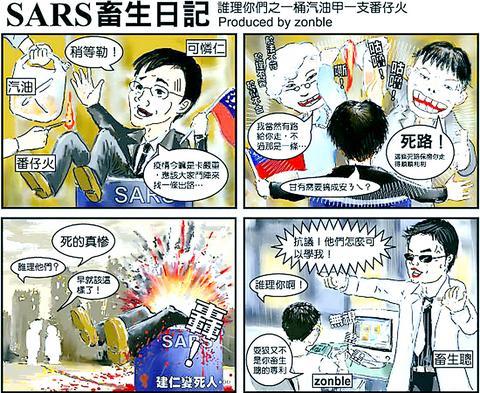Daniel Defoe chronicled London's 1665 bubonic plague outbreak in Journal of a Plague Year, which was published in 1722, or 57 years after the epidemic. Artistic reactions to Severe Acute Respiratory Syndrome (SARS) have come much quicker.
The SARS Art Project, an Internet-based gallery that's gathered SARS inspired works from around the world, went online between mid and late-May. The project's custodian, Los Angeles-based writer Xeni Jardin, calls it a "collection of digital folk art, or these sort of funny little found images that you sort of stumble across online."

PHOTO COURTESY OF SARSART.ORG
It began, she said, with images by anonymous or unknown creators that were passed around in e-mail chains, then went on to include art she commissioned from professional artists.

PHOTO COURTESY OF SARSART.ORG
Now mostly complete, the online gallery displays a large assortment of images and links to sites and multimedia works, like the satirical, animated monster movie Godzilla vs. SARS (In it, Godzilla faces off with a cloud/monster-bodied SARS virus, defeating it with a breath blast fuelled by American cough syrup). There are also more introspective looks at the disease that originated in affected areas, like Beijing, Toronto, Hong Kong and Taiwan.
The first image Jardin got a hold of was Outbreak Girl, a digitized t-shirt design of a raver girl wearing a surgical mask. The source was threadless.com, a Chicago-based t-shirt company.
It was a fitting beginning for what was to become a pure internet event. Jardin posted Outbreak Girl along with a few other images on boingboing.net, an interactive web journal where she's active, and asked for more submissions. It was mid-May, and although the SARS epidemic had been in Asia's headlines for weeks, for Jardin in Los Angeles felt like that was the height of the media hype in the US.
The information channel she was tapping into was that of Web journals, or blogs. The term stems from Web logs and denotes sites mostly by amateur journalists.
Jardin herself is a blogger as well as a professional journalist and in April was involved in a project that brought the two forms together, the war blog of CNN correspondent Kevin Sykes in Iraq. When interviewed by the Taipei Times, she frequently referred to the SARS Art Project as a product of the "blogosphere" and noted how it's drawn from
bloggers worldwide.
Wen Ling (
Wen provided Jardin with digital photos of temperature checks in Beijing, similar to those at most building entrances in Taipei. Simply journalistic, his shots differed from the imaginative digital creations in the online gallery.
Jardin said her project aimed to transcend geography in understanding the epidemic. "Now somebody in Oklahoma or Paris or whatever can get more of a street level feel for what people were seeing and thinking [in affected areas], and that's an amazing thing."
Wen agreed the SARS Art Project was "very good" but said there were too few Beijing contributions.
In a picture of Darth Vader wearing a surgical mask from Florida and ironic illustrations from artists in LA, Washington DC and Vancouver, Wen didn't see much he could relate to. About half of the images in the SARS Art Project were made by North Americans in non-affected areas. "I think a lot of people thought the idea of wearing masks was funny and something to play with. What they didn't realize was that this disease was really terrifying," Wen said.
Works from SARS zones -- about half those included in the project -- often have a different feel. One of the most striking is a photo of a young woman with tan lines from a surgical mask across her face. The outline in skin tones seems to signal a new kind of taboo, as now the face has become a private zone. The connotations are of lost innocence and perhaps even a future of lost identity.
Jardin received the picture in a chain of e-mails she cannot trace back to an original source, but the caption in simplified Chinese characters, "This summer is past" (
If the results are sometimes mixed, it may be because in creating art exhibitions for the blogosphere, Jardin is exploring such new territory. "This is the first time that I'd been involved in a project where we were soliciting the creation of art from the general online public and from digital artists, she said.
Then, by measure of explaining her goals for the new medium, "I went to art school at the San Francisco Art Institute. I come from a family of professional artists. One reason that I became sort of disillusioned or alienated from that world when I was younger is that it felt so separate from the rest of the world. And I wanted to do things with my life that felt more inclusionary."
Though she has not achieved the stature of Defoe's event-defining work, she seems motivated by the same spirit.
The SARS Art Project can be viewed online at http://www.sarsart.org.

Wooden houses wedged between concrete, crumbling brick facades with roofs gaping to the sky, and tiled art deco buildings down narrow alleyways: Taichung Central District’s (中區) aging architecture reveals both the allure and reality of the old downtown. From Indigenous settlement to capital under Qing Dynasty rule through to Japanese colonization, Taichung’s Central District holds a long and layered history. The bygone beauty of its streets once earned it the nickname “Little Kyoto.” Since the late eighties, however, the shifting of economic and government centers westward signaled a gradual decline in the area’s evolving fortunes. With the regeneration of the once

Even by the standards of Ukraine’s International Legion, which comprises volunteers from over 55 countries, Han has an unusual backstory. Born in Taichung, he grew up in Costa Rica — then one of Taiwan’s diplomatic allies — where a relative worked for the embassy. After attending an American international high school in San Jose, Costa Rica’s capital, Han — who prefers to use only his given name for OPSEC (operations security) reasons — moved to the US in his teens. He attended Penn State University before returning to Taiwan to work in the semiconductor industry in Kaohsiung, where he

In February of this year the Taipei Times reported on the visit of Lienchiang County Commissioner Wang Chung-ming (王忠銘) of the Chinese Nationalist Party (KMT) and a delegation to a lantern festival in Fuzhou’s Mawei District in Fujian Province. “Today, Mawei and Matsu jointly marked the lantern festival,” Wang was quoted as saying, adding that both sides “being of one people,” is a cause for joy. Wang was passing around a common claim of officials of the People’s Republic of China (PRC) and the PRC’s allies and supporters in Taiwan — KMT and the Taiwan People’s Party — and elsewhere: Taiwan and

On May 2, Chinese Nationalist Party (KMT) Chairman Eric Chu (朱立倫), at a meeting in support of Taipei city councilors at party headquarters, compared President William Lai (賴清德) to Hitler. Chu claimed that unlike any other democracy worldwide in history, no other leader was rooting out opposing parties like Lai and the Democratic Progressive Party (DPP). That his statements are wildly inaccurate was not the point. It was a rallying cry, not a history lesson. This was intentional to provoke the international diplomatic community into a response, which was promptly provided. Both the German and Israeli offices issued statements on Facebook